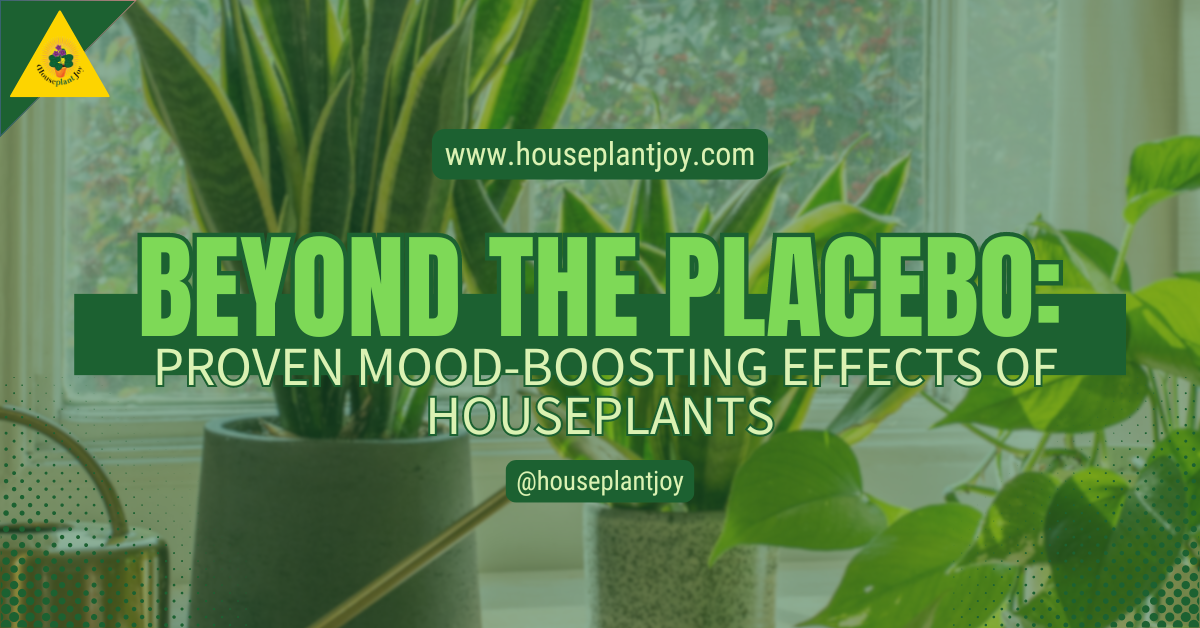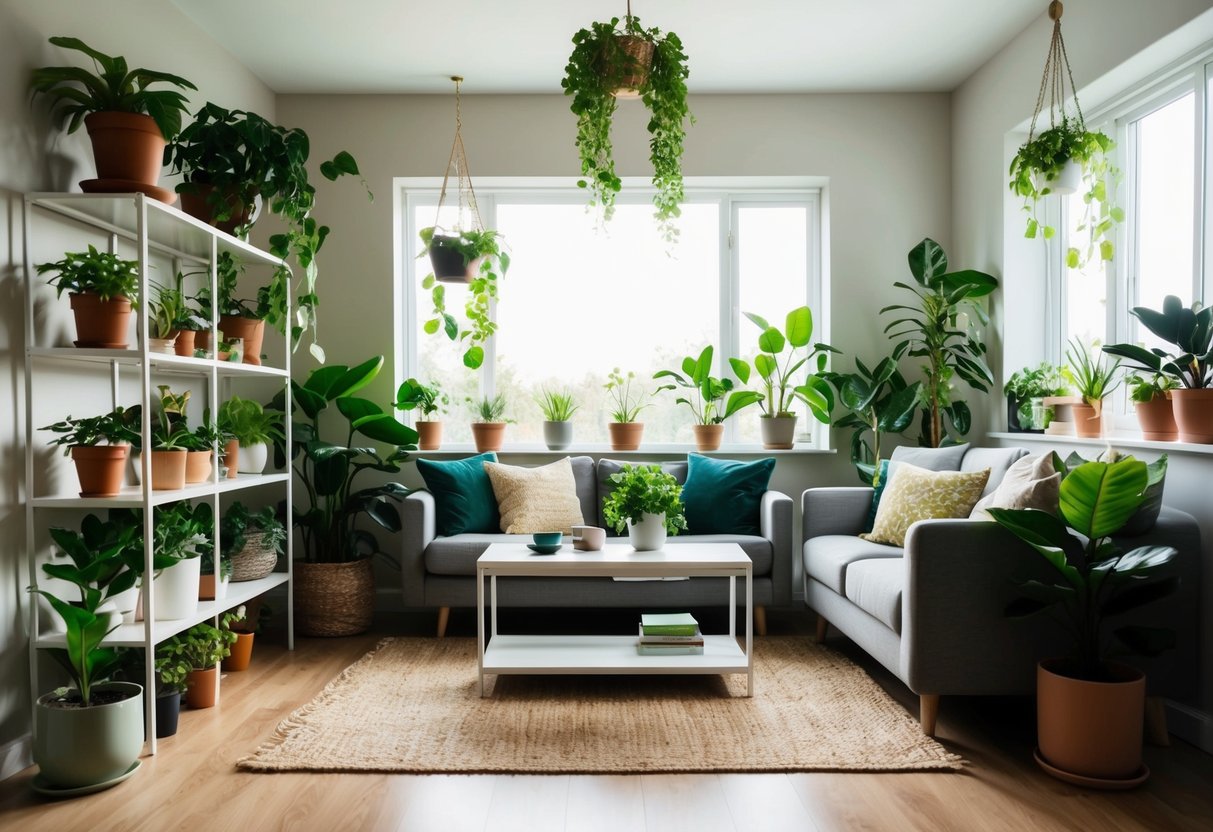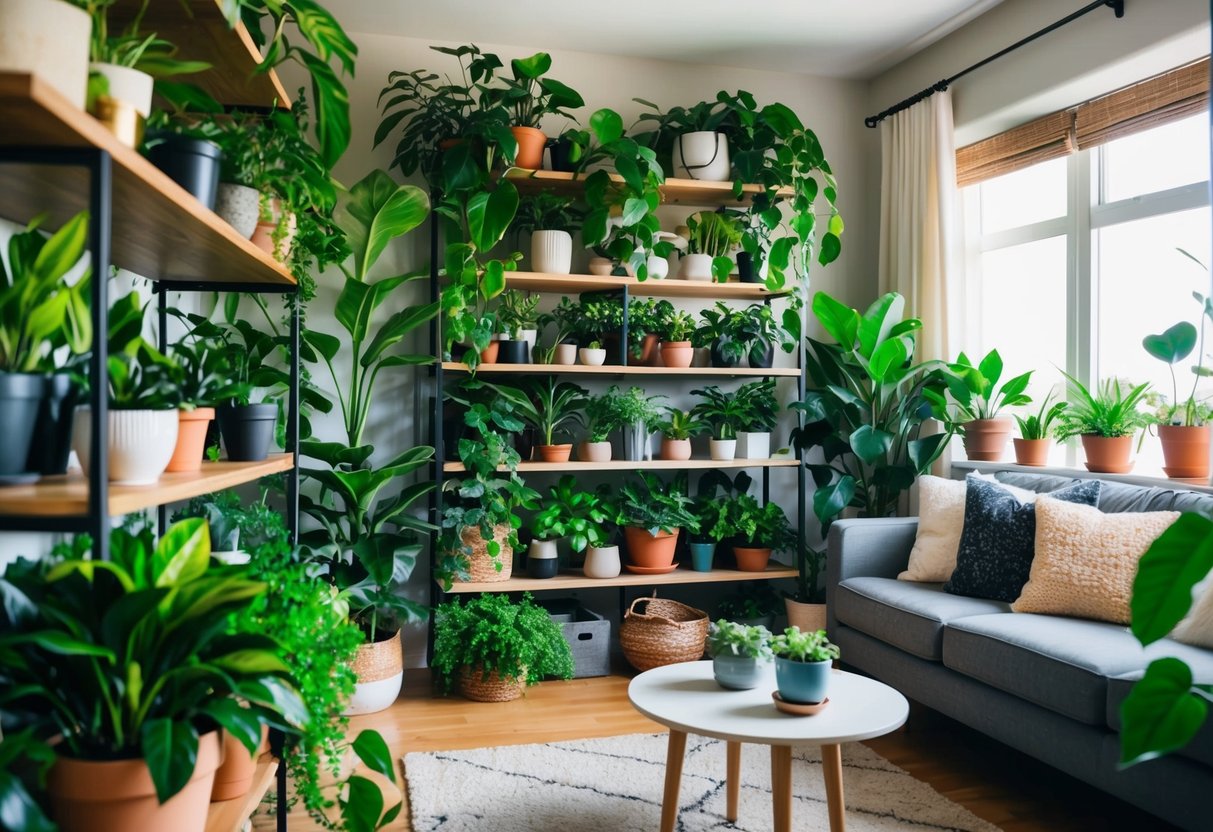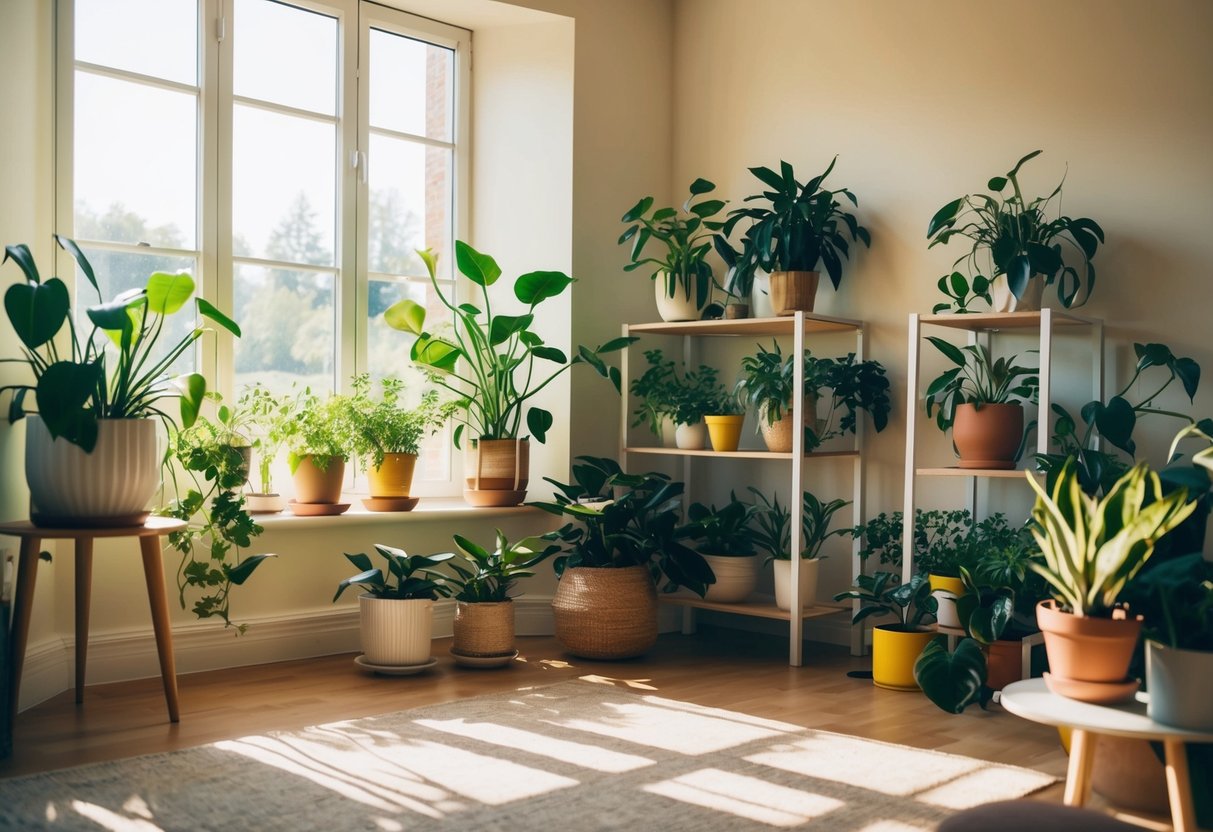HousePlantJoy is supported by our audience. When you purchase through one of our links, we may earn a small affiliate commission. As an Amazon Associate I earn from qualifying purchases. Your cost is not affected.
==================
Feeling a little down in the dumps? No need to fret—your houseplants have your back! These leafy companions aren’t just for looks; they actually pack a serious punch when it comes to boosting your mood and lifting your spirits. Let’s explore how these green friends can brighten your mood and why chatting with them might just make your day a little better. Ready to boost your mood with some plant magic? Let’s dive in!
Beyond the Placebo: Proven Mood-Boosting Effects of Houseplants – Green Friends That Lift Your Spirits
Houseplants are so much more than just home décor—they can actually boost our mood and create a sense of calm. I’ve always enjoyed having plants around, but it wasn’t until I dug deeper into their benefits that I realized just how much they can positively impact our well-being.
Plants like peace lilies and spider plants can reduce stress and improve our mood. It’s not just in our heads either – there’s real science behind it. These green friends clean the air we breathe and create a peaceful setting that helps us relax.
I’ve found that taking care of plants gives me a sense of purpose too. Watching them grow and thrive makes me feel good. It’s like having a little bit of nature right in my living room, even when I can’t get outside. Plus, they make great conversation starters when friends come over!
The Science of Houseplants and Mood Improvement
I’ve always been curious about how plants affect our emotions. It turns out there’s real science behind it! Studies show that having indoor plants can boost our mood and make us feel better. Plants do more than just look pretty. They can actually change how we feel inside. When I’m around plants, I notice I feel calmer and less stressed.
I find it fascinating that different plants have different effects. For example, peace lilies create a calm feeling while spider plants lift our spirits. Caring for plants can be good for us too. It gives us a fun hobby and helps us learn new things. I love watching my plants grow – it makes me feel proud and happy.
Scientists have done lots of research on this topic. They’ve found that plants can improve our mental health in many ways. It’s not just in our heads – plants really do make a difference! I think it’s amazing how something as simple as a houseplant can have such a big impact on how we feel. Nature is pretty incredible!
Types of Houseplants and Their Unique Benefits
I’ve found that different houseplants can boost my mood in various ways. Some offer lush greenery, others bright blooms, and many even clean the air we breathe. Let’s explore the benefits of foliage plants, flowering varieties, and air-purifying options.
Foliage Plants: More Than Just Greenery
Foliage plants add a refreshing touch of nature to any room. The peace lily is one of my favorites. Its bright green leaves and white blooms can help reduce stress and improve mood.
Another great option is the aglaonema. I love how its colorful leaves with splashes of pink, red, and white can instantly cheer up a space. It’s also pretty easy to care for, which is a bonus for beginners like me.
For a bold statement, I’d recommend a large, leafy plant like a monstera or fiddle leaf fig. These can serve as natural room dividers, adding structure and a touch of the outdoors to your home.
Flowering Plants: Lifting Spirits with Color
When I need a quick mood boost, I turn to flowering plants. Orchids are a fantastic choice. They bloom for months and come in a variety of colors. I find their delicate petals so uplifting. Kalanchoes are another great option. These little plants produce clusters of cheery flowers in bright reds, pinks, and yellows. They’re sure to bring a smile to your face.
For a seasonal touch, I love Christmas cactuses. Their fiery red and pink blooms are perfect for brightening up dark winter days. And let’s not forget about jasmine – its sweet fragrance can really lift your spirits.
Air-Purifying Plants: Clean Air for a Clear Mind
Some plants do double duty by cleaning the air while boosting our mood. I’m a big fan of the snake plant. It’s great at removing toxins from the air and is super easy to care for. Spider plants are another excellent choice. They’re known for removing formaldehyde from the air, and they’re fun to propagate too. I love watching the little “spiderettes” grow.
For a splash of color and air-purifying power, I’d recommend the purple waffle plant. It’s effective at removing volatile organic compounds from the air, and its purple leaves add a unique touch to any room.
Psychological Effects of Houseplants
Houseplants can have amazing effects on our minds. I’ve seen how they can change the way we feel and think. Let me share what I’ve learned about their psychological benefits.
Reduction of Stress and Anxiety
When I’m feeling stressed, I like to look at my plants. It really helps. Studies show that being around plants can lower heart rate and blood pressure. This means less stress for us. I’ve noticed that caring for plants gives me a sense of calm. It’s a simple task that takes my mind off worries. Watering, pruning, and watching them grow is very relaxing.
The green color of plants is soothing to our eyes. It reminds us of nature and can help us feel more peaceful. Even a small plant on my desk can make a big difference in how I feel during a busy day.
Improving Focus and Productivity
I’ve found that having plants around helps me concentrate better. They seem to clear my mind and make it easier to focus on tasks. Research backs this up. Scientists have discovered that plants in offices can boost productivity. People work faster and make fewer mistakes when there are plants nearby.
Plants also help clean the air. This means we breathe better, which is good for our brains. Cleaner air can help us think more clearly and stay alert longer.
Enhancing Creativity
Whenever I need a creative boost, I look to my plants for inspiration. Their shapes, colors, and patterns can spark new ideas. Plants connect us to nature, which is a great source of creativity. I’ve noticed that spending time with my plants helps me think outside the box and come up with fresh concepts.
Some plants, like lavender, have scents that can boost mood and creativity. I keep a small lavender plant on my desk for this reason. Its gentle aroma helps me feel more inspired and imaginative throughout the day.
The Role of Indoor Plants in Health Recovery
I’ve found that plants can help people get better faster when they’re sick or hurt. In hospitals, patients with plants in their rooms often heal quickly. They need less pain medicine and feel less tired and worried. Plants make the air cleaner too. They remove toxins and add moisture. This helps people breathe easier, especially those with breathing problems.
I’ve noticed that being around plants can lower stress levels. When we’re less stressed, our bodies can focus more on getting well. It’s amazing how a simple plant can make such a big difference!
Effects on Blood Pressure and Heart Rate
Plants can calm us down in ways we can see on medical tests. I’ve read studies that show indoor plants can lower blood pressure. This is great news for heart health.
When we look at plants, our heart rate often slows down too. It’s like our bodies relax just by seeing green leaves. This can happen even if we’re not trying to relax. I find it fascinating that something as simple as a potted plant can affect our vital signs. It’s a natural, easy way to help our hearts stay healthy.
Selecting the Right Plants for Your Environment
I always consider light levels when choosing plants. For sunny spots, I love succulents or cacti. They’re low-maintenance and thrive in bright light.
For shadier areas, I go for snake plants or ZZ plants. They can handle low light and don’t need much water. I also think about my schedule. If I’m busy, I pick hardy plants that don’t need daily care. Spider plants and pothos are great options.
For beginners, I suggest starting with easy plants like:
- Peace lilies
- Rubber plants
- Chinese evergreens
Placement Strategies for Optimal Benefits
I like to put plants where I spend the most time. A small herb garden in the kitchen adds fresh flavors to my cooking. In my office, I place a peace lily on my desk to reduce stress while I work.
For the bedroom, I choose calming plants like lavender or jasmine. Their scent helps me relax before bed. I use hanging planters to save floor space in small rooms. Wall-mounted pots are great for adding greenery without clutter. I group plants of different sizes to create a natural, layered look. This adds depth and interest to any room.
Maintenance and Care for Healthy Plants
I water my plants when the top inch of soil feels dry. Overwatering is a common mistake, so I’m careful not to soak them. I dust plant leaves regularly with a damp cloth. This helps them absorb more light and stay healthy.
I fertilize my plants every few months during the growing season. A balanced, water-soluble fertilizer works well for most plants. I watch for signs of pests or diseases. Yellow leaves or small bugs can mean trouble. I address issues quickly to keep my plants thriving.
Lastly, I repot my plants when they outgrow their containers. This gives their roots more space to grow and keeps them happy.
The Practice of Mindful Plant Care
When I care for my plants mindfully, I feel more relaxed and focused. I take a few deep breaths and observe each plant closely and gently touch the leaves, noticing their texture and color. This helps me spot any issues early on.
I also talk to my plants softly while watering them. It might sound silly, but it makes me feel good. I use all my senses – the smell of damp soil, the sound of water trickling, the sight of droplets on leaves.
Reduced stress levels are linked to interacting with plants like peace lilies. Their calming effect is quite noticeable.
Developing a Routine for Engagement
I’ve created a simple plant care routine that I look forward to each week. Here’s what it looks like:
- Monday: Check soil moisture and water if needed
- Wednesday: Dust leaves and inspect for pests
- Friday: Rotate plants for even sunlight exposure
- Sunday: Prune any dead leaves or stems
This routine helps me stay consistent with plant care. It also gives me regular moments of calm in my busy schedule. I keep a small journal to track my plants’ growth and any changes I notice. It’s fun to look back and see how much they’ve grown over time.
Joining Local and Online Plant Communities
I love being part of plant communities. Local garden clubs often have houseplant groups. I’ve met great people at meetings and plant swaps. We trade cuttings and share care advice.
Online, there are tons of options. Facebook groups and Reddit communities are full of plant fans. I follow Plant Instagram accounts for inspiration. There are even plant swap events in some neighborhoods. These groups welcome new members. It’s easy to ask questions and learn. I’ve made friends who share my passion for plants.
Sharing Experiences and Advice
Talking about plants is half the fun for me. I love swapping stories about tricky plants we’ve grown. We celebrate when someone’s stubborn orchid finally blooms. Online forums are great for quick advice. If I notice weird spots on leaves, I can post a pic. Other plant parents chime in with ideas. We learn new things all the time.
I enjoy helping newbies too. It feels good to pass on what I’ve learned. The plant community is so supportive and friendly.
Fun Fact
Did you know that houseplants can actually boost your focus and creativity? Studies show that having greenery in your workspace can enhance concentration and spark creative thinking by up to 15%. The presence of plants creates a more soothing and visually stimulating environment, reducing mental fatigue and helping you stay sharp and inspired throughout the day. Whether you’re tackling a big project or brainstorming new ideas, your leafy companions might just be the secret to unlocking your full potential!
Beyond the Placebo: The Science Behind Plant-Powered Mood Boosts
It’s pretty cool how something as simple as having plants around can make such a big difference in how we feel. Beyond just looking nice, they help us focus, relax, and even breathe a little easier. If you haven’t already, I’d definitely recommend adding a few plants to your space. It doesn’t take much—just a snake plant or a pothos can do the trick! You might be surprised at how quickly they lift your mood and brighten your day. So why not give it a shot? Your future plant parent self will thank you!
Ready to harness the power of plant-powered mood boosts? Share your plant stories and experiences with our community. Let’s inspire each other to create thriving indoor gardens and cultivate a happier, healthier lifestyle.
Can indoor plants help improve my mood?
What are some scientifically proven benefits of having indoor plants?
How do houseplants reduce stress and anxiety levels in individuals?
Are there any negative impacts of keeping plants indoors on human health?
Which indoor plants are best for promoting mental wellness?
Be Part of the Houseplant Joy Community!
Are you a plant enthusiast, whether you’re just starting out or already have a thriving indoor jungle? Houseplant Joy is your go-to hub! Connect with fellow plant lovers who share your passion for nurturing all things green.
Stay inspired with expert tips, discover unique plants, and swap your best plant-care stories. Don’t miss the chance to grow with us—follow along and let’s cultivate something beautiful together!









